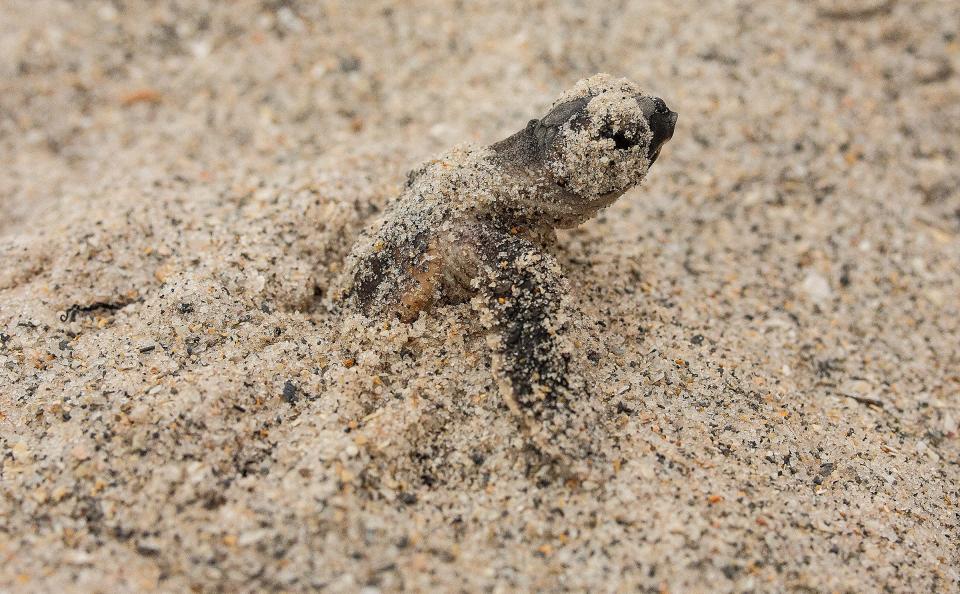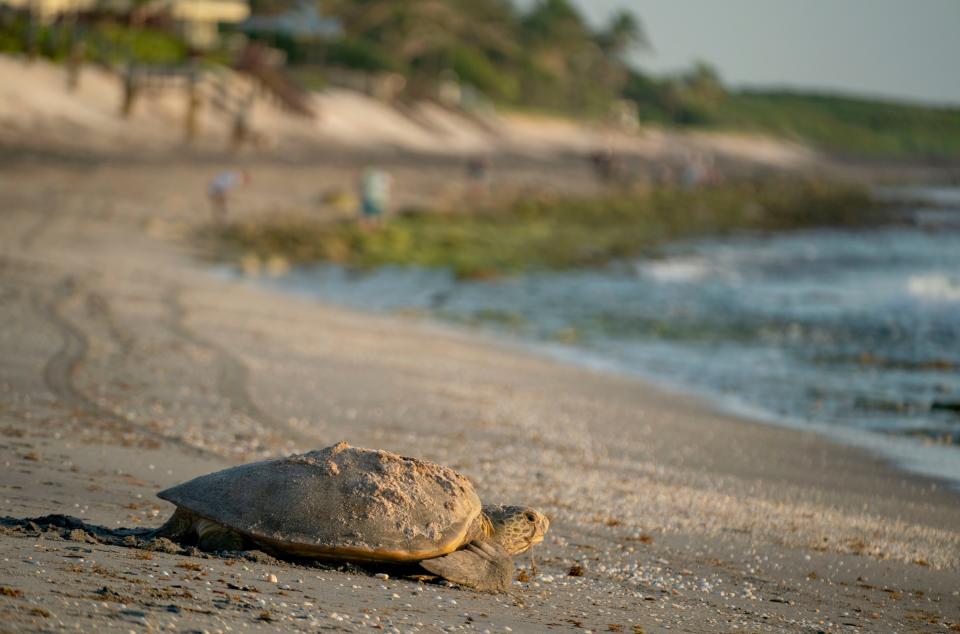'Never seen before:' Sea turtles likely to break nesting records on Jupiter-area beaches
JUNO BEACH — Records are meant to be broken, and sea turtles nesting in Palm Beach County are well on their way.
Scientists and volunteers have identified a whopping 17,138 sea turtle nests in the Juno Beach, Jupiter and Tequesta areas so far this summer, according to a news release from the Loggerhead Marinelife Center.
At just halfway through this year's nesting season — which runs from March 1 to Oct. 31 — Loggerhead staff expect to scream past last season's final number of 18,132 nests on the 9.5-mile stretch of beach they monitor.
“We are observing nesting numbers in amounts never seen before,” said Justin Perrault, vice president of research at Loggerhead Marinelife Center. He said he expects the total number of nests to top 20,000 this year: A record for this slice of Palm Beach County.
Watch: Sea turtle nesting season is here: See baby turtles emerge from their nests
The record has already been broken farther south on the five miles of beaches monitored by Gumbo Limbo Nature Center in Boca Raton — which have recorded 1,185 sea turtle nests so far this season. Last year, the same area had 1,058 nests, according to David Anderson, the center's sea turtle conservation coordinator.
"It's encouraging," Anderson said Saturday about the ever-increasing nesting numbers. "These are animals that don't reach maturity until 20 or 25 (years of age), so we need many, many years of data to understand the trends we're seeing."
While researchers don't yet understand how all sea turtles nesting habits fluctuate, at least one type of sea turtle follows a two-year reproductive cycle that results in high numbers of nests every other year. The last "high" year for green sea turtle nests in Florida was 2019, according to the Florida Fish and Wildlife Conservation Commission.
Loggerhead Marinelife Center researchers also attribute the higher nesting numbers to successful conservation in the last several decades. As a result, sea turtles are able to return to their native beaches to lay their nests more than 20 or 30 years into their lives.
Halfway through the season, northern Palm Beach County sees nesting numbers that rival last year
Three types of sea turtles regularly nest on Palm Beach County's beaches: The prolific loggerhead, the slightly smaller green turtle, and the massive leatherback. All three species are threatened or endangered.
As of July 12, staff and volunteers have documented 208 nests from leatherbacks, 12,379 from loggerheads, and 4,551 nests from green turtles.
Compare that to the entire season in 2022, when nest monitors found 282 nests from leatherbacks, 13,205 from loggerheads, and 4,645 nests from green turtles.
Northern Palm Beach County, from John D. MacArthur State Beach Park to the Martin County line in Tequesta, usually accounts for about half of all sea turtle nests in the county. Last year, there were a total of 37,183 nests in Palm Beach County, according to FWC.

Trends in sea turtle nesting in Florida and Palm Beach County
Palm Beach County and our neighbors have always been hotspots for sea turtle nesting. More than 80% of all loggerhead sea turtle nests in Florida are found in central east and southeast parts of the state, according to the FWC.
But some nesting trends don't yet make sense.
Green turtles usually follow a two-year reproductive cycle, and the species set record high nest-counts in 2011, 2013, 2015, 2017 and 2019. Then, the years between 2020 and 2022 did not follow the typical two-year cycle, but were classified as "intermediate" years by FWC.
Changes in the green turtle's two-year cycle have been documented in the past as well — from 2003 to 2004 and from 2010 to 2011. The FWC says these changes are not cause for concern, and that nest counts may resume their two-year cycle or the nesting pattern may change all together.
"These greens have kept us guessing these last few years," Anderson said. "Maybe their population has grown to the point where we won't see obvious high and low years."
Meanwhile, leatherback nests reached a peak in Florida and in Palm Beach County around 2014, followed by a steep decline between 2015 and 2017.
Now, leatherbacks have made a "promising rebound," according to FWC. Leatherback nest numbers have surpassed 2014 levels in Palm Beach County, according to Loggerhead Marinelife Center's data.

Harassment on Palm Beach County beaches, warmer sea water threaten sea turtle lifecycles
Risks to sea turtles and their futures have been highlighted by recent allegations of "harassment" of the endangered species and higher ocean temperatures.
Last week, a group of residents sent a notice that they intend to sue the Town of Palm Beach for violations of the federal Endangered Species Act because the town is not enforcing its light restrictions designed to protect hatching sea turtles on the beach, The Palm Beach Post reported.
The group Bear Warriors United said mechanical beach cleaning machines leave deep ruts in the sand that stop newly hatched sea turtles from making it to the ocean, and that sea turtle nests are being improperly marked and then disrupted by beachgoers and unleashed dogs.
“The town of Palm Beach could have these issues fixed and be heroes in a week if they put their minds to it,” said Katrina Shadix, executive director of Bear Warriors United. “This isn’t a poor town. It’s one of the richest ZIP codes in the country and they could be sea turtle champions.”
More: Sea turtles harassed in Palm Beach, according to letter warning of endangered species lawsuit
Nesting sea turtles are also facing troubles even before they get to the beach.
Palm Beach County's sea-surface temperatures are three degrees warmer than normal this month at around 88 degrees, according to the National Oceanic and Atmospheric Administration.
Warmer water could spell trouble, because as water temperatures climb, coral reefs experience "bleaching" that kills part of the organism. As the main source of food for sea turtles and many other sea creatures, dying coral reefs can cause a domino effect on the entire ocean ecosystem, according to the Sea Turtle Conservancy.
Kimberly Miller, a veteran journalist for The Palm Beach Post who covers real estate and how growth affects South Florida's environment, contributed to this report.
Katherine Kokal is a journalist with a special interest in sea turtles who covers education at The Palm Beach Post. You can reach her at kkokal@pbpost.com. Help support our work, subscribe today!
This article originally appeared on Palm Beach Post: Sea turtle nests near record on northern Palm Beach County beaches

